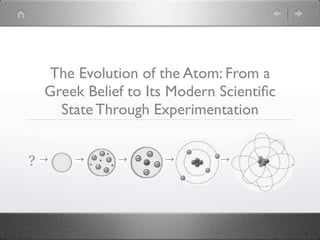
Evolution of the Atom
- 1. The Evolution of the Atom: From a Greek Belief to Its Modern Scientific State Through Experimentation ?
- 2. A Greek Belief Greeks where ineterested in knowing what the world is made of. • Thales ofofMiletus (ca.640-546 B.C.) What is the nature matter? • Leucippus (490-? B.C.) Can one endlessly devide matter?
- 3. • Democritus (460-370the division of amatterof Leuccipus. Called the limit of B.C.) was pupil atomos. = the atom Matter He said everything, except the void, consists of a collection of atoms. ~ Plato and Aristotle did not accept atoms.
- 4. • Epicurusteachings. B.C.) took atomism as central core of his (341-270 • Titus Lucretius Carus Natura. B.C.) was an Epicurean. Wrote De Rerum (96-55 Christianity accused atomists of atheism • Pierreand adopted atomism. He shared the philosophy. Natura Gassendi (1592-1655) read De Rerum
- 5. The Collection of Evidence Experimentation • Robert Boyle (1627-1691) became an atomist inlfuenced by Gassendi’s writings. In 1662 Boyle proved the inverse relationship between pressure and volume, which atomism explained easily.
- 6. • Joshep LouisLaw of definite proportions.in 1799 determined the Proust (1754-1826) Proust said that the atom O is indivisible; it exist as Cu O a whole piece or as C nothing. This is also what Democritus said. O
- 7. • John Dalton determining the Law1803 built on Proust’s Law by (1766-1844) in of multiple proportions.With it he brought more credibility to atoms which he named as a tribute to Democritus. Carbon Monoxide arbon Dioxide C In 1808 Dalton published New System of Chemical Philosophy with which he established the modern atomic theory.
- 8. • RobertofBrownparticles he saw ininhis experimentthe behavior pollen (1733-1859) 1827 called Brownian motion. James Clerk Maxwell worked out the theory of constant motion of atoms mathematically around 1860. Albert Einstein worked out equations that described Brownian motion and helped Jean Baptiste Perrin calculate the size of atoms. • Erwin Wilhelmthat could magnify the pointinof1936 imagined a device Mueller (1911-1977) a fine needle until seeing the atoms lined up as luminous dots. In 1955 such atoms were seen.
- 9. • William Crookes (1832-1919) in 1878 built a Crookes tube: an improved Geisser tube. Made a little wheel inside the tube turn when the greenish glow hit it. Was the greenish glow particles or waves?
- 10. • Joseph John Thompson with a better vacuum tube repeated Hertz’s experiment (1856-1940) in 1897 and stronger charge plates. He convinced others that cathode rays consisted of speeding cathode-ray particles, each carrying a negative electric charge. Cathode-ray particles are to electricity what an atom is to matter. Thompson measured its mass to be significantly smaller than the mass of the atom.
- 11. George Johnstone Stoney called the cathode-ray particles electrons. Thompson referred to them as “corpuscles.” In 1898 Thompson was the first to suggest an atomic structure taking an electric charge into account. Plum pudding model
- 12. • Hantarowith some things about Thompson’s model. disagreed Nagaoka (1865-1950) in 1904 Nagaoka believed the positive charge in the atom did not take up as much volume as the electron and that it was located in the atomic center. • Ernest Rutherford (1871-1937) in 1909 directed the Geiger-Mardsen experiment, better known as the gold foil experiment, disproving Thompson’s atomic model and proving the existence of an atomic nuleus.
- 13. Nucleus takes 99.945% to 99.975% of the atom’s mass
- 14. • Niels Bohr Rutherford’s planetary atomic but further was based on in 1903 proposed his model model which explained. Postulate I: electrons revolved in circular orbits where their angular momentum is an integral multiple of h/2 π. The orbits are around the nucleus and are stationary states. Postulate II: The energy of the atom has a definite value in a stationary orbit. If an electron jumps from a high energy orbit, it emits a photon. In order for an electron to jump from a lower energy orbit to a high ebergy orbit, it must absorb energy from a source.
- 15. • James Chadwick (1891-1974) in 1932 her performed the experiment Irene Joliot-Curie and husband had been studying and thus dicovered the neutron.
- 16. Sources
Editor's Notes
- \n
- \n
- \n
- \n
- \n
- \n
- \n
- \n
- \n
- \n
- \n
- \n
- \n
- \n
- \n
- \n
- \n
